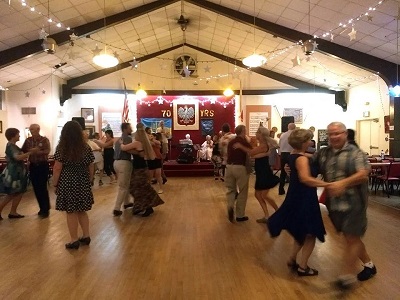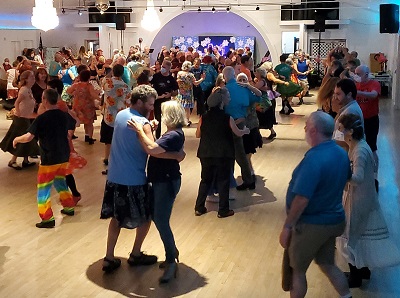
Contradancing is a form of American dance in which the dancers form a set of two parallel lines that run the length of the hall. In each dance, couples dance a sequence of moves that take them up or down the set. As the sequence is repeated, a couple will eventually dance with every other couple in the set and through the course of an evening, with nearly every other dancer.
Contradances have a relaxed, family-like atmosphere where the emphasis is on dancing. It is excellent exercise, which you can take at your own pace. Above all, contradancers form a community of friendly, active people who love to dance and welcome new dancers.
Many of the basic moves in contradancing are similar to those in traditional square dancing (swings, promenades, dos-à-dos, allemandes). A square dance set comprises only four couples whereas the number of couples in a contradance set is limited only by the length of the hall. To join the set, all you need is a partner. If you have danced squares, you will enjoy contras immediately.
Even if you have never contradanced before, your feet are never asked to do more than walk to the music. Each dance is taught by the caller before it is danced. The caller continues to prompt the dancers as needed. Because the pattern of moves of each contradance is repeated often, contradances are easy to learn. Both beginning and experienced dancers happily share the same set.
If you don’t have a partner, that’s not a problem. Many people come to a contradance alone. There are many people to dance with and dancers are encouraged to dance with many different partners throughout the evening. If there is an excess of one gender, it’s okay to dance the other gender’s part. The important thing is to get up and have a good time dancing.
No special clothes are required for contradancing. People tend to dress informally. Most people dress for comfort and in anticipation of vigorous exercise. Be sure to wear soft-soled, comfortable shoes.
Contradancing is usually done to live music. Traditional jigs, reels, and hornpipes from the Scot-Irish tradition as well as French Canadian tunes form the basic repertoire.
Credits
This text is a slightly modified version of “A Contra Dance Primer” by Les Francey and Farrell Boyce, of the Hamilton Country Dancers (Ontario, Canada)


